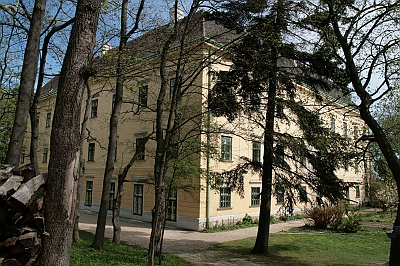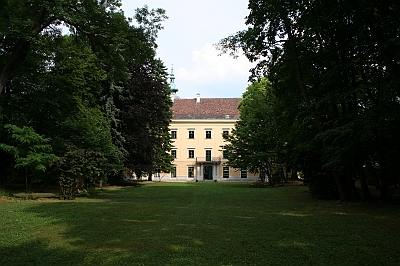The castle in Ober Sankt Veit has a long, eventful history. As early as 1194 until around 1280/90, it was the seat of Austrian noble families. In 1361, Stefan von Toppel sold the castle.

The buyer was none other than Duke Rudolf IV, the donor. (The painting is in the Diocesan Museum in Vienna on St. Stephen's Square).
The duke had married the daughter of Emperor Charles IV, Catherine of Luxembourg, in St Vitus Cathedral in Prague in 1353. St. Vitus Cathedral had already been partly rebuilt in
the Gothic style by order of Emperor Charles.
Rudolf wanted to imitate his father-in-law and in 1359 laid the foundation stone for the Gothic extension of St Stephen's Church in Vienna. The desire for a separate bishopric for St. Stephen and for independence from Passau failed due to the Pope's veto. However, Rudolf succeeded in establishing a cathedral chapter independent of the Passau bishop. This cathedral chapter, which still exists today, was given a patrocinium of All Saints, which has been the second patrocinium of the cathedral ever since.
On 16 March 1365 (on the Sunday of Easter), Rudolf gave this cathedral chapter, among other things, "the Vest ze Sand Veyt auf der Wienn and all that belongs to it, which we have remounted and cleared out with our own bodies". At that time, the duke and his retinue rode around the area of the dominion, which was not precisely delimited, and had it marked with boundary markers. On the same day, Duke Rudolf granted the chapter the court of death (the right to pass a death sentence for crimes) in the estates of St. Stephen's Cathedral and the cathedral chapter.

Entrance to Ober St. Veit Castle
In 1465, the parish of St. Vitus was assigned to the newly established diocese of Vienna and thus left the area of the diocese of Passau. The castle and dominion of St. Vitus then came into the possession of the diocese of Vienna, founded by Emperor Frederick III, by imperial decree, together with the possession of the provostry of St. Stefan, which did not really come into being until 1480. (With the bull of Pope Paul II, the bishopric of Vienna was established in 1469 at the instigation of Emperor Frederick III).
The Turks burnt down the castle together with the Ober St. Veit church in 1529. But the bishops rebuilt the castle and church. There is evidence that Bishop Nausea (1542/43) and Bishop Neuböck (1579) lived here.
In the years 1650-1654, Bishop Philipp Count Breuner had the castle converted into a baroque, representative residence. The castle still looks like this today. The tower, however, was demolished in 1742 under Archbishop Sigismund Kollonitsch.

An engraving by Georg Matthäus Vischer (1672) shows the castle still with a tower, but essentially in its present form.

The photo dates from 1890.
On 1.2.1762 Archbishop Cardinal Migazzi sold the palace and manor to Maria Theresa, who arranged for the painting of the interiors (ground floor and some rooms on the 2nd floor on the east side) by Johann Bergl.

In 1779, the Archbishopric of Vienna bought it back. An archiepiscopal school was established and part of the premises was used as a dormitory.
During the French occupation in 1809, the castle was used as a military hospital. Archbishop Firmian (1822-31) had the devastated castle renovated, the garden replanted and avenue trees planted along Hietzinger Hauptstrasse.

Subsequently, the castle was used as the summer residence of the archbishops until the 1930s. The archbishop's art collection was housed here until 1933. Then all the objects were transferred to the Cathedral and Diocesan Museum.

The existing school was transformed into the "Seminary for Church Vocations" in 1964. Until 2014, pastoral assistants were trained in this training school for pastoral vocations.
Since 2014, the neocatechumens, a Catholic sect, have moved in.

The castle is best photographed in winter. The picture was taken in January 2011.
In the chapel, which no longer exists, was the so-called St. Veit altar (from the circle of Albrecht Dürer). Today it is in the Cathedral and Diocesan Museum on Stephansplatz, as is the church's Gothic monstrance.
Ober St. Veiter Monstrance
Sources: Dr. Josef Kraft: From the past of Ober-St.Veit
Website of the Cathedral Chapter of St. Stephen